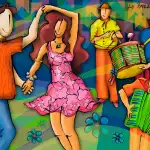Curiosities and Challenges about Forró
Do you like Forró?
Would you like to see more curiosities like these..
Forró is an art form originating in the Northeast region of Brazil. It is widely accepted as one of the main Brazilian....
During the dance, people shifted their feet to contain the rising dust. That's why the name "rastapé" or..
The denomination forró was used for the first time to designate this melody and dance only in 1950, a year after the....
So.. How about a Challenge on the Best Quiz Platform in the World?
It's poetry in the form of music
Get to know a little about everything and bet on your knowledge in incredible challenges and duels..
Join the betspot.zone community, accumulate bts (bets) and even compete for prizes..
Discover some interesting facts about Forró..
Brazilian music Quiz - Brazilian music Curiosities -Brazilian music Challenge - - Frequently asked questions about Forró
Electronic forró raises many discussions among fans of the t

Electronic forró raises many discussions among fans of the traditional one, however it achieves great success throughout the country, especially among young people. The song has connection with the guitar, drums and keyboard. It is a very popular forró genre and the dances are hectic, containing complex movements. The main names of this type of music are Aviões do Forró, Wesley Safadão, Calcinha Preta, among other artists.
publicity
Forró pé de serra emerged in the mid-1940s and

Forró pé de serra emerged in the mid-1940s and is the most classic of all. Normally, it is formed by a team composed by the triangle, accordion and zabumba. The movements are basic and determined by simply turning the partner. Several important figures emerged from it, such as Luiz Gonzaga, Gonzaguinha and Genival Lacerda among others.
Forró pé de serra emerged in the mid-1940s and

Forró pé de serra emerged in the mid-1940s and is the most classic of all. Normally, it is formed by a team composed by the triangle, accordion and zabumba. The movements are basic and determined by simply turning the partner. Several important figures emerged from it, such as Luiz Gonzaga, Gonzaguinha and Genival Lacerda among others.
Historians suggest that the word forró came from the term fo

Historians suggest that the word forró came from the term forrobodó, a Galician-Portuguese variation of 'forbodó', originating from the French faux-bourdon, which could mean "de-intonation". One unverified theory is the name was coined from an English expression. British engineers settled in the Pernambuco area during the construction of the Great Western Railroad. They threw parties for important leaders, then opened the celebration for everyone. Tickets were marked with the term "para todos", Portuguese for "for all" - "forró" - when pronounced by northeastern natives.
publicity
In the 80's, forró underwent a transformation

In the 80's, forró underwent a transformation, with some extra instruments being incorporated, such as drums, guitar and electric bass. During the 90's, more elements were added to the bands, including keyboards and sax. there was a new look at this musical genre, thus appearing the university forró that made certain musical alterations in relation to its original version. It is often confused with baião, xaxado and xote due to the obligatory presence of the zabumba, accordion and triangle; It can also be referred to as 'forró pé de serra' or traditional forró.
The denomination forró

The denomination forró was used for the first time to designate this melody and dance only in 1950, a year after the singer Luiz Gonzaga recorded his song "Forro de Mané Vito". Previously, the compositions were based on the way of life in the Brazilian Northeast. Its plot ranged from joys to sadness generated by the problems of this people, often talking about distant loves, homesickness, etc. Therefore, the 13th of December is known as National Forró Day and also celebrates the birthday of Luiz Gonzaga, known as The King of Baião.
During the dance

During the dance, people shifted their feet to contain the rising dust. That's why the name "rastapé" or "foot drag" arose. The rhythm was also influential in Dutch, Portuguese and European ballroom dances. It is important to mention that the toré, an indigenous celebration where sometimes the participants drag their feet on the ground resembles the characteristic choreography of forró.
publicity
Forró

Forró is an art form originating in the Northeast region of Brazil. It is widely accepted as one of the main Brazilian musical styles, in addition to being considered national cultural intangible heritage. In addition, it also encompasses a particular type of dance. Originally known as "forrobodó", the origin of forró can be related to popular events that took place in the latter part of the 19th century. At that time, it was essential to moisten the ground where these celebrations were held, as it had no coating and the dance took place on the ground itself.
Back
